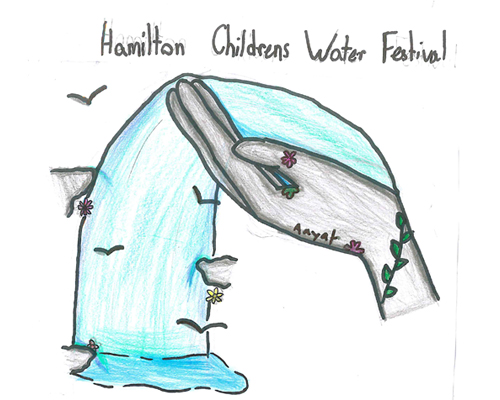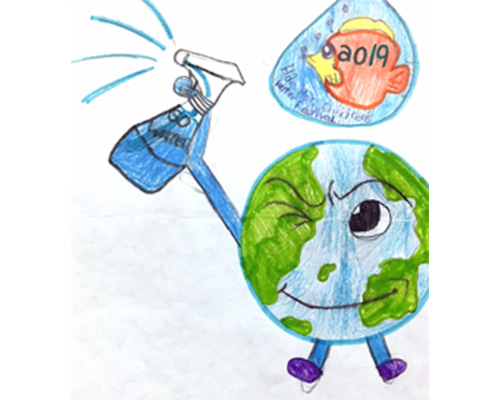Children's Water Festival

For additional information
Email [email protected]
IMPORTANT: Registration for the 2026 Hamilton Children’s Water Festival will begin January 28, 2026. The registration form will become available on this page in December 2025.
The Hamilton Children’s Water Festival in 2026 will take place in-person (with virtual activities available) and is an opportunity to educate students about the importance of water conservation, protection, awareness, respect, science technology, history and health. Teachers can register to attend one of three festival days. Space is extremely limited and spaces are filled on a first come, first served basis. Each activity is based on the Ontario Curriculum and are provided by our close community partners such as Green Venture, the Royal Botanical Gardens, the City of Hamilton, McMaster University and many more!
Event Details
- Who Grade 4 Teachers and their students
- What Hamilton Children’s Water Festival
- Where Pier 4 Park - 64 Leander Dr, Hamilton
- When May 26 to May 28, 2026
- Why To give students a new respect for water and the environment as well as make them aware of local water issues.
- Cost Free event
The ultimate goal is to foster decision-makers, initiate the process of behavioural change, to empower children to initiate change within their homes, schools and communities, and to encourage children to become catalysts for change by taking information and new found respect back to their own environment.
2025 Sponsors and Community Partners
The Hamilton Children’s Water Festival would not be possible without the generous support of sponsor organizations who help keep this event free and the community partners who dedicated their time and effort to providing educational activities. Hamilton Water would like to thank the following organizations for their support:
Sponsors
Community Partners
Interested in becoming a sponsor or community partner? Email [email protected]
Activity Details
Hot Potato Hand Wash
Presented by City of Hamilton, Public Health
In this activity students will learn the importance of hand washing in preventing the spread of infection. They will also learn the proper technique of hand washing through the use of glitter bug lotion and a series of fun activities!
Fish of Hamilton Harbour
Presented by Hamilton Harbour Remedial Action Plan / Conservation Halton
Students catch, identify, and measure different species of fish and discuss how the types of fish found in Hamilton Harbour can help determine the water quality and health of an ecosystem, and how we can understand what is safe to eat.
Aqua Invaders
Presented by the Hamilton Conservation Authority
What is an invasive species and how do they harm our aquatic ecosystems? Through an active game students will learn more about invasive species and why they can be so hard for ecologists to combat once they enter into an ecosystem.
What's Beneath Our Feet: Mapping Underground Mysteries
Presented by City of Hamilton, Utility Locates
Did you know there are thousands of kilometers of pipes buried right under your feet? In this activity, students learn first hand how the City of Hamilton Utility Locates team finds this hidden infrastructure.
Stormwater Runoff
Presented by Bay Area Restoration Council (BARC)
In this interactive activity your students will learn about the issues of stormwater runoff. Using a visual model, students will see the process of stormwater runoff and explore concepts like point source and nonpoint source pollution. Students will be able to interact with the model and see how pollution makes its way into our local waterways!
Getting Back to Our Roots
Presented by Presented by City of Hamilton, Forestry
In this activity each student will learn about why trees are important, water conservation related to tree planting, nursery production and storage. Each student will plant a bare root tree in a fibre pot and will learn to take care of the tree. Each student will take their tree home or back to class to nurture and care for.
The Filtration Station
Presented by ArcelorMittal Dofasco
This activity will teach students the importance of wastewater treatment, how it is treated using filtration, and the value of ArcelorMittal Dofasco’s wastewater treatment process. The filtration plants are a large component in ensuring the water is adequate not only for the purposes of the plant, but also for the harbour. The students will participate in a water filtration activity where they will have the opportunity to make their own wastewater and treat it.
Wastewater - How Industries Manage It
Presented by Hamilton Industrial Environmental Association (HIEA)
This activity will help students better understand how industries similar to municipalities manage wastewater. Using the local steel industry as an example, students will learn what wastewater is and how we clean it to ensure that it is safe for humans, animals, and the environment.
Safari Niagara Outreach: What's With the Wetlands?
Presented by Safari Niagara
Wetlands are an important type of ecosystem. They cover Canadian lands and help with water filtration, protection from flooding, and biodiversity. We will have informative videos and signage, and some fun activities. Come discover wetlands and the animals that inhabit them.
Water Treatment Plant
Presented by City of Hamilton, Hamilton Water
A working model of a drinking (potable) water treatment plant process illustrates the chemical and physical principles in water treatment. The water treatment plant receives raw water from lakes, rivers or ground water. The raw water goes through a screening and sedimentation process before the water is filtered through sand filters. Chlorine may be added in one or more places along the treatment train to provide enough time for chlorine to destroy pathogens in the water. The treated water is then pumped from the treatment plant throughout the City using pipes, pumps, and water reservoirs to Hamilton homes.
A Drop in the Bucket
Presented by City of Hamilton, Hamilton Water
Even if the Earth is covered mainly by water, only a small amount is available for human consumption. This demonstration will illustrate the distribution of freshwater resources versus salt water and the actual amount of available freshwater in the world. Through a quantitative demonstration students will visualize that water is a limited resource.
Osprey Survivor
Presented by The Hamilton Naturalists’ Club
Students will investigate how Osprey (also known as seahawk, fish hawk or fish eagle), a fish-eating bird of prey, feed themselves and their young. Students will also find out how pollutants affect Osprey and how they can help keep the Osprey’s food source pollutant free. Teams try to ‘catch’ as many fish by putting on the wings and running to the ‘pond’, returning with a fish to the ‘nest’ within the required time. Upon their return and when all fish are gone, each team will calculate the healthiness of their catch based on the quality of fish they have caught.
Run, Salmon, Run
Presented by the Hamilton Conservation Authority
Students will complete an obstacle course inspired by the journey salmon must make each year as they travel to their spawning grounds. They will navigate rocks, jump over dams, and travel through culverts as they race to reach their finish line.
Put Waste in the Right Place
Presented by City of Hamilton, Environmental Services
Children will have the opportunity to become Waste Champions by learning where every day items that they see at home and in school should be placed for disposal after they have been used! Through an interactive game the students will be able to put their new found knowledge to the test and see if they really know how to sort their waste into the proper bins.
Bugs N’ Slugs
Presented by City of Hamilton, Hamilton Water
We flush our toilet and put water down the drain and never think of where it goes. What would happen if everything we flushed down the toilet went directly into the lake? Once you flush the toilet the water and sewage go through the sewer lines under the streets to the treatment plant. Here, it is processed and cleaned. A model of a wastewater treatment plant shows the treatment processes on the sewage and the solids collected in the process.
Trip of a Drip
Presented by The Hamilton Museum of Steam and Technology
The Hamilton Museum of Steam and Technology is home to Hamilton’s first Waterworks built in 1859. Before water was pumped to people’s homes the citizens of Hamilton relied on well water located around the city. The problem was this water was polluted. This activity takes children back in time by allowing them to learn about water, waterborne diseases and how clean water is pumped from Lake Ontario to their homes.
pHish Race
Presented by City of Hamilton, Hamilton Water
Students will learn what pH is, how it is linked to pollution and that it affects aquatic habitats. They will be challenged to think of ways in which humans directly influence a pH change in aquatic habitats. Students will learn how to check pH and determine the pH of some water samples.
Water Main Break
Presented by City of Hamilton, Hamilton Water
In this activity, students will learn and understand how their drinking water gets from the Water Treatment Plant to their faucet or toilet. With sections of actual water main, with valves, shut offs and fire hydrants, students will be able to respect the enormous infrastructure that Hamilton has underground and goes unnoticed. The students will be able to see what a water main break looks like and will experience and help fix the water main as the City of Hamilton employees do.
Waterfront Trolley Ride
Presented by Hamilton Waterfront Trust / BARC
This activity will take the class on a tour of Bayfront Park. A member from the Fish and Wildlife Restoration Program will provide commentary that will educate students on life in the harbour. This activity will allow students the chance to see the revitalization that has taken place along the waterfront.
Fixing Flooding
Presented by Green Venture
Have you ever stepped in a puddle on a city street? Think of all the things that could be in there - pesticides, fertilizers, even animal poop! When rainwater isn't absorbed into the ground, these are all swept into our waterways. Try your skills at solving this problem by creating your own mini city.
Only Rain Down the Drain
Presented by City of Hamilton, Hamilton Water
Students will learn that a catch basin leads to the natural environment and only rain water or snow can go into a catch basin. We will discuss what happens when common household products are disposed of in the incorrect location. This could lead to pollution our water and have effect on our fish and plant life. For example, paints cleaners, gasoline cannot go to a catch basin and should be taken to a Community Recycling Centre.
Online activities
Activities will be made available for classes that are unable to register for the in-person event. These activities are adapted from the in-person versions and cover all of the same topics. Please e-mail [email protected] if you wish to access these activities. They will be made available in May 2025.







